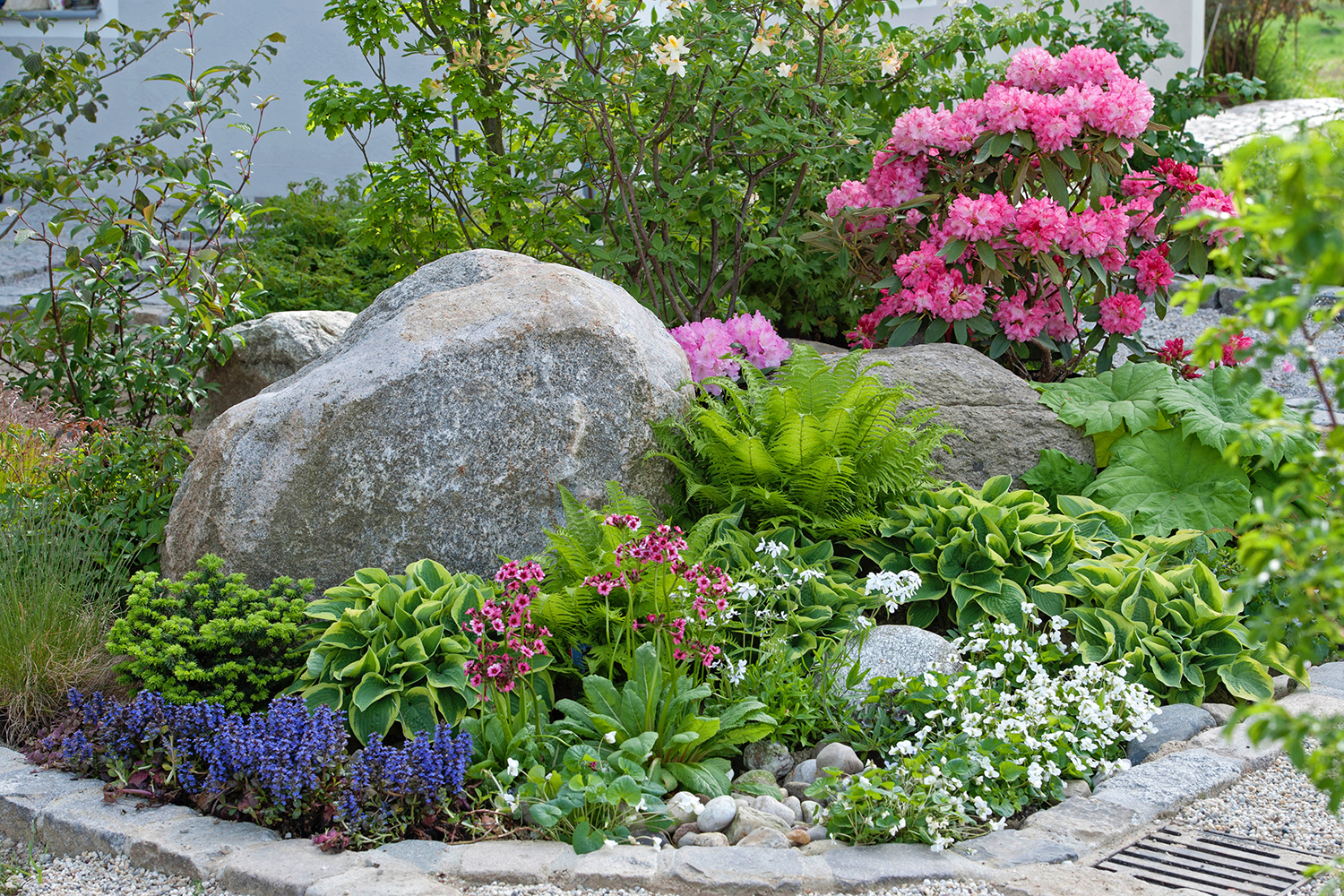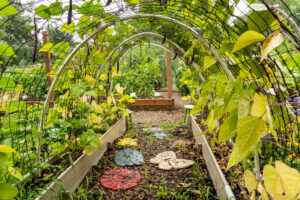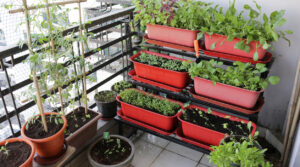Modern Rock Garden Ideas: Transform Your Landscape With Stunning Rockery Designs
A well-designed rock garden blends natural stone elements with carefully selected plants to create a compelling landscape feature that requires minimal maintenance while delivering maximum visual impact. Today’s modern rock gardens have evolved beyond the traditional alpine style to embrace contemporary design principles, sustainable practices, and innovative materials. Whether you’re working with a naturally rocky yard or starting from scratch, these modern rockery ideas will help you create a distinctive outdoor space that stands the test of time.
Why Rock Gardens Are Making a Contemporary Comeback
Rock gardens originated centuries ago as a way to showcase alpine plants and mimic mountainous landscapes. In today’s landscape design world, they’ve experienced a renaissance for several compelling reasons:
- Water conservation becomes increasingly important in many regions, and rock gardens typically require significantly less irrigation than traditional lawns.
- Low-maintenance landscapes appeal to busy homeowners seeking beautiful outdoor spaces without extensive upkeep requirements.
- Climate resilience is built into well-designed rock gardens, which can withstand temperature extremes and weather fluctuations.
- Year-round structure provides visual interest even during dormant seasons when other garden elements may lack appeal.
- Habitat creation for beneficial insects and pollinators when incorporating native plants and varied microclimates.
“The most successful modern rock gardens balance natural elements with intentional design,” says landscape architect Marcus Rivera. “They should appear as though they belong in the landscape rather than looking artificially constructed.”
Essential Elements of Modern Rockery Designs for Small Gardens
Creating an effective rock garden in a limited space requires careful consideration of scale, materials, and composition. Unlike sprawling traditional rock gardens, modern small-space designs focus on these key components:
Strategic Stone Selection and Placement
The foundation of any rock garden is, unsurprisingly, the rocks themselves. When working with limited space:
- Choose varying sizes for natural appearance, with a few larger statement stones (24-36 inches) anchoring the design.
- Select complementary stone types rather than mixing geologically dissimilar materials.
- Bury approximately one-third of each stone’s height to create a naturally settled appearance.
- Position stones with their best face forward and natural strata lines running in the same direction.
- Create planting pockets between rocks for root development and proper drainage.
Black basalt, slate, and limestone are popular choices for contemporary rock gardens, offering distinct textures and colors that complement modern architecture. For smaller gardens, lighter-colored stones like sandstone or granite can help create a sense of spaciousness.
Thoughtful Plant Selection
Modern rock gardens often feature a more curated plant palette than their traditional counterparts:
- Architectural succulents like Agave, Aloe, and Echeveria provide strong forms and year-round interest.
- Ornamental grasses such as Festuca glauca, Muhlenbergia capillaris, and compact Miscanthus cultivars add movement and seasonal transformation.
- Drought-tolerant perennials including Lavandula, Achillea, and Penstemon offer color while withstanding challenging conditions.
- Compact conifers like Juniperus ‘Blue Star’ or Pinus mugo ‘Pumilio’ provide permanent structure at a manageable scale.
- Ground-hugging spreaders such as Sedum, Sempervivum, and creeping thyme that cascade over and between rocks.
“The most successful small rock gardens limit the plant palette to create cohesion,” explains Kevin Chang, professional gardener and rock garden specialist. “I recommend selecting no more than 7-10 plant species for gardens under 100 square feet to avoid a cluttered appearance.”
Aesthetic Rock Garden Ideas for Contemporary Landscapes
Modern rock gardens often incorporate design principles from minimalism, Asian influences, and sustainable landscaping practices to create distinctive looks.
Minimalist Zen-Inspired Designs
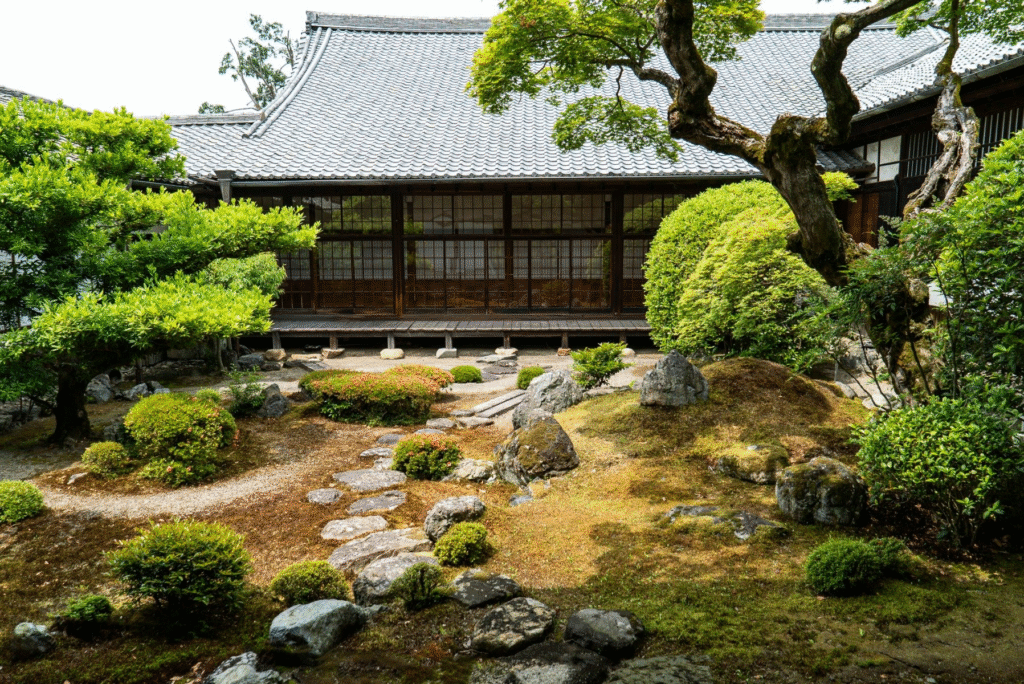
Characterized by restrained plant selections and thoughtful negative space, minimalist rock gardens create contemplative outdoor environments:
- Use larger stones with significant space between them, positioned asymmetrically
- Incorporate fine gravel raked in patterns around major elements
- Select plants with subtle color variations and similar textures
- Limit the palette to 3-5 plant species with controlled growth habits
- Include a simple water feature like a stone basin or small bubbling rock
This style works particularly well in courtyard gardens, entrance areas, and side yards where a sense of calm transition is desired.
Vertical Rock Garden Installations
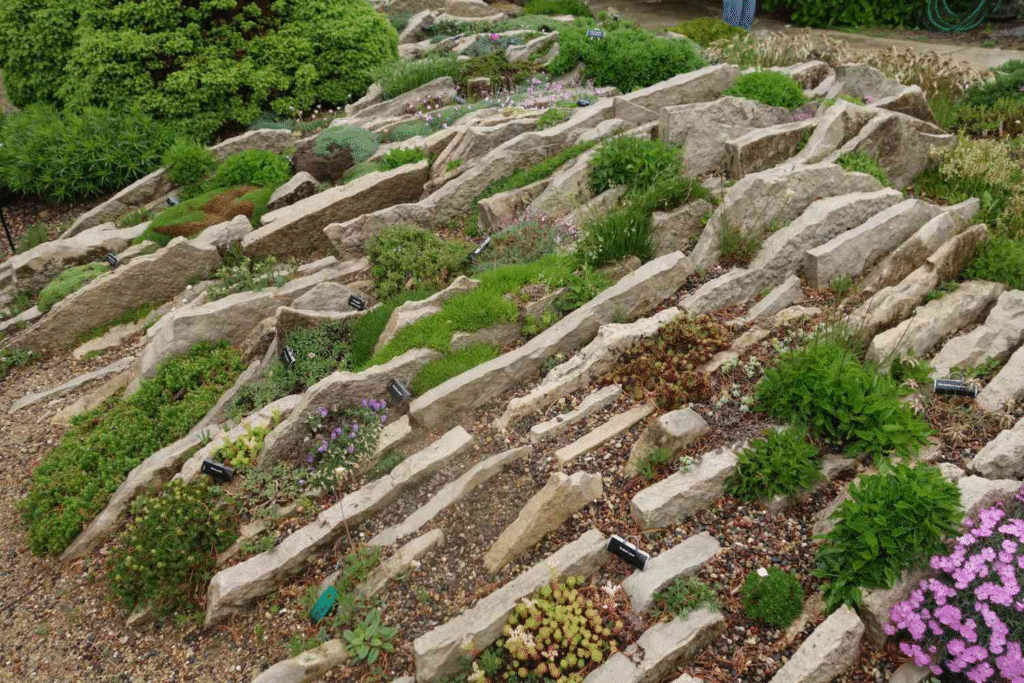
When horizontal space is limited, vertical rock gardens offer a solution for challenging areas:
- Living walls with integrated rock elements and pockets for succulent plantings
- Stacked stone systems that create terraced planting areas
- Gabion walls (wire cages filled with stones) that double as planting structures
- Rockery steps that transition between garden levels while supporting alpine plants
“Vertical rock gardens make excellent use of retaining walls, steep slopes, and boundary areas,” notes landscape designer Elena Moretti. “They transform potential problem zones into garden highlights.”
Desert-Modern Fusion
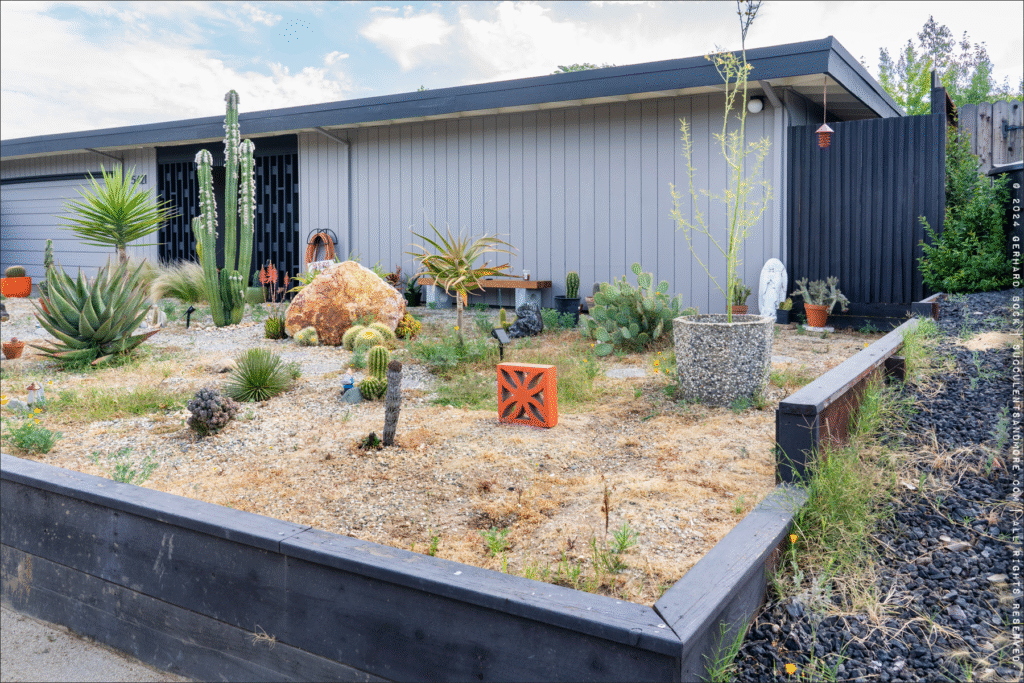
Drawing inspiration from arid landscapes, this style combines clean lines with dramatic plant forms:
- Pair angular boulders with architectural plants like Yucca, Dasylirion, and Hesperaloe
- Incorporate crushed stone or decomposed granite in geometric patterns
- Use Corten steel edging to create definition between rock garden sections
- Select a monochromatic plant palette with occasional dramatic accent colors
- Include sculptural elements that complement the angular nature of the stones
This approach works particularly well in regions with water restrictions or in front yards where low-maintenance, high-impact landscapes are desired.
Landscaping Ideas for Naturally Rocky Yards
When your property comes with existing rock outcroppings or rocky soil, working with these natural features rather than against them can create distinctive gardens.
Embracing Natural Rock Features
Sites with existing rock outcroppings provide excellent opportunities for authentic-looking rock gardens:
- Clear the area around natural rock features, removing weeds and undesirable vegetation
- Enhance drainage by incorporating gravel and sand in planting areas
- Add complementary stones that match the existing geology
- Create planting pockets with quality soil mix formulated for rock garden plants
- Select plants that would naturally grow in similar conditions in the wild
“The most convincing rock gardens build upon what nature has already provided,” says geologist and garden designer Thomas Reynolds. “Look to nearby natural areas for inspiration on how plants and rocks coexist in your region.”
Transforming Rocky Soil Challenges
If your challenge is rocky soil rather than attractive outcroppings, consider these approaches:
- Stone sorting to utilize excavated rocks by size and type
- Raised berms constructed with rocky subsoil and topped with quality growing medium
- Dry creek beds that incorporate smaller rocks while managing water flow
- Boulder clusters created from larger rocks to establish focal points
- Path integration using smaller rocks and stepping stones
“Rocky soil is actually an asset for drainage-loving plants,” explains soil scientist Dr. Maya Peterson. “The key is selecting appropriate plants rather than fighting against your site conditions.”
Small Backyard Rock Garden Ideas
Limited space can actually produce some of the most impactful rock garden designs when thoughtfully executed.
Pocket Rock Gardens
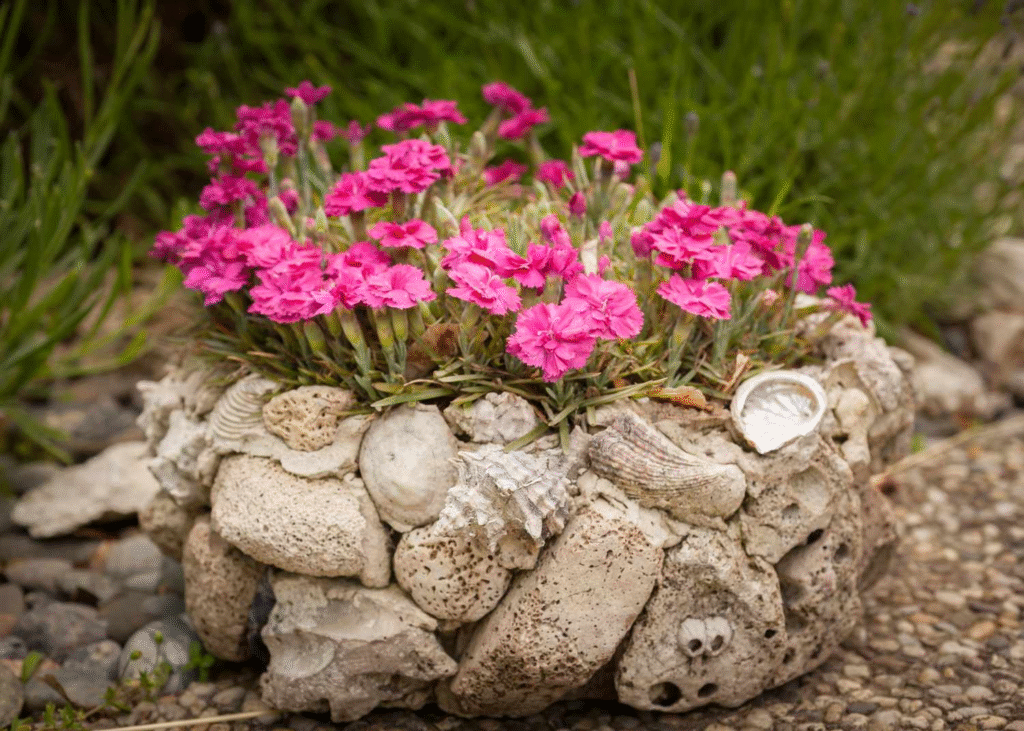
These concentrated rockery installations make excellent use of awkward corners, side yards, or areas near patios:
- Focus on a single dramatic boulder as a focal point
- Surround with compatible smaller stones to create natural grouping
- Select miniature plant varieties that won’t quickly outgrow the space
- Incorporate small-scale elements like a tiny bubbling water feature
- Use contrasting gravel to define the area and suppress weeds
“A well-designed pocket rock garden of just 4×4 feet can contain all the elements of a larger installation,” notes small space garden designer Jordan Kim. “The key is appropriate scaling of all components.”
Container Rock Gardens
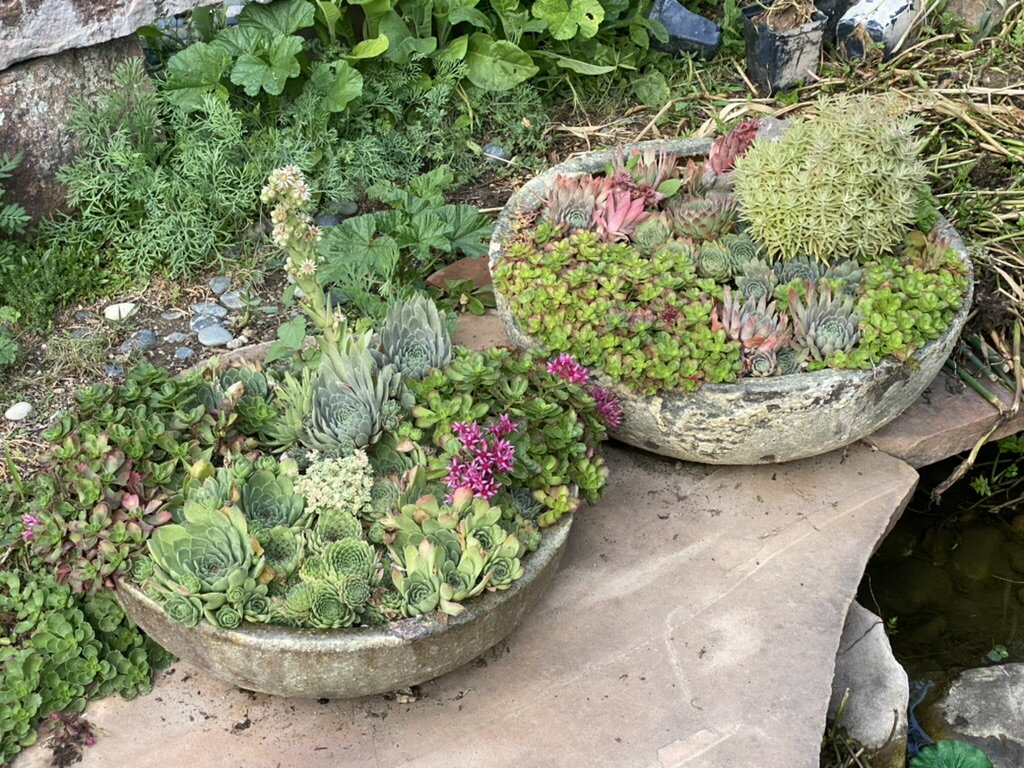
For the smallest spaces or for renters, container rock gardens offer flexibility:
- Use wide, shallow containers at least 12 inches deep for adequate root space
- Create proper drainage with gravel layers and drainage holes
- Position smaller rocks to create microclimates and visual interest
- Select miniature varieties of traditional rock garden plants
- Group multiple containers for greater impact
These portable rockeries can be positioned on patios, balconies, or even rooftop gardens to bring the aesthetic to any outdoor space.
Multi-Functional Rock Garden Designs
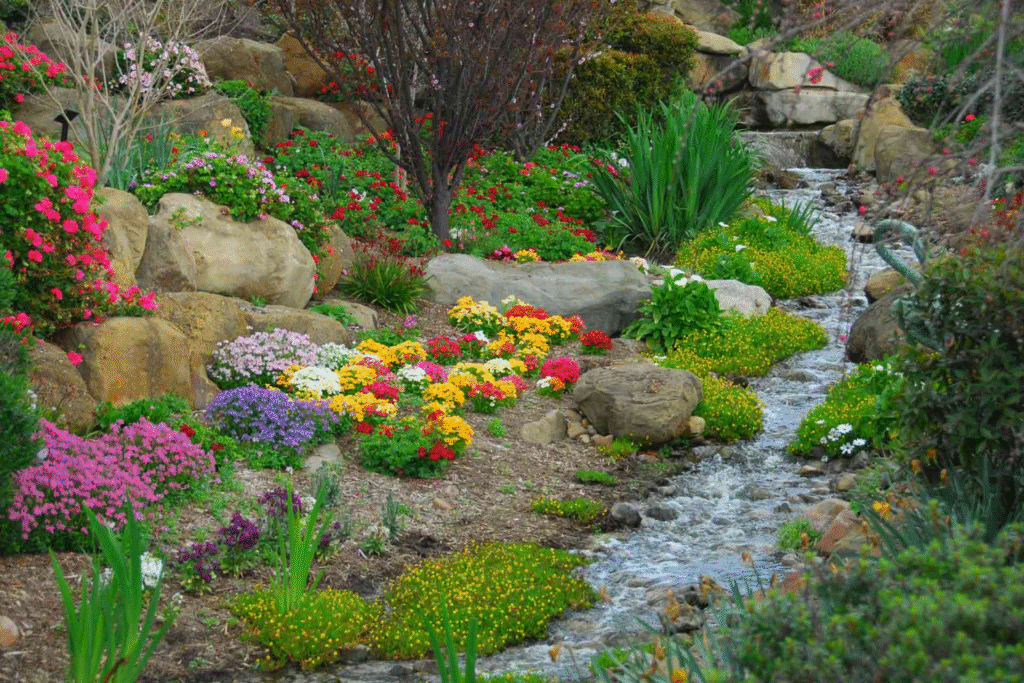
Modern rock gardens often serve multiple purposes, especially in limited spaces:
- Rock garden seating walls that double as planting areas
- Stepping stone pathways integrated with ground-hugging plants
- Boulder fire pit surrounds that incorporate heat-tolerant succulents
- Water-harvesting rock gardens that capture and utilize rainfall
- Wildlife-supporting rockeries with features for beneficial insects and birds
“The most successful small space designs make every element work harder,” explains urban landscape architect Sophia Williams. “A rock that’s just decorative represents a missed opportunity in a small garden.”
Sustainable Practices for Modern Rock Gardens
Today’s rock gardens should embrace ecological principles while maintaining aesthetic appeal.
Water-Wise Design Strategies
Modern rock gardens excel at conservation when properly designed:
- Capture and direct rainfall with strategically positioned rocks and swales
- Group plants by water needs to maximize irrigation efficiency
- Install drip irrigation hidden among rocks for establishment phase
- Use rock mulch to reduce evaporation around plantings
- Create shade pockets with larger rocks to protect sensitive plants
“A thoughtfully designed rock garden can reduce landscape water usage by up to 80% compared to traditional planting schemes,” notes water conservation specialist Rebecca Chen. “This makes them especially valuable in drought-prone regions.”
Habitat Creation
Rock gardens provide excellent opportunities for supporting local ecosystems:
- Include flat rocks that warm quickly as basking spots for beneficial insects
- Create crevices and small caves for shelter and hibernation spaces
- Incorporate small water features that serve as drinking spots
- Select native plants that support local pollinators
- Position rocks to create varied microclimates supporting diverse species
“Even the smallest rock garden can become a biodiversity hotspot,” explains ecological landscape designer Marcus Thompson. “The structural complexity of rocks creates numerous ecological niches.”
Materials and Construction for Lasting Rockery Designs
Creating a rock garden that stands the test of time requires proper materials and construction techniques.
Stone Selection Guide
The stones you choose will define your rock garden’s character:
| Stone Type | Characteristics | Best Uses | Considerations |
|---|---|---|---|
| Limestone | Light color, often with fossils | Traditional rock gardens, alkaline-loving plants | Gradually dissolves in acidic conditions |
| Sandstone | Warm colors, layered textures | Modern designs, creates natural-looking strata | Softer surface allows for plant colonization |
| Granite | Durable, varied colors, speckled appearance | Contemporary designs, heavy-wear areas | Heavier and more difficult to position |
| Basalt | Dark color, columnar or rounded forms | Asian-inspired and modern designs | Creates dramatic contrast with light-colored plants |
| Local fieldstone | Varies by region, authenticates the garden | All styles, especially naturalistic approaches | Most sustainable option, reduces transportation impact |
“Always source stone ethically,” advises sustainable landscape designer Isabella Martinez. “Avoid collecting from wild areas, and work with reputable stone yards that can verify their supply chain.”
Proper Installation Techniques
To ensure your rock garden thrives for years:
- Prepare proper foundation with 4-6 inches of drainage material
- Install landscape fabric in areas prone to aggressive weeds
- Position largest stones first, ensuring stability and proper placement
- Create soil pockets with appropriate growing medium for selected plants
- Address drainage issues thoroughly before planting
- Install irrigation if needed before completing rock placement
“The most common rock garden failure is inadequate drainage,” cautions landscape contractor Michael Johnson. “Invest time in creating the proper foundation, and your rock garden will thrive for decades.”
Seasonal Considerations for Year-Round Appeal
Modern rock gardens should provide interest across all seasons.
Spring Planning
- Position spring-flowering bulbs between rocks during fall installation
- Include early-blooming alpine plants like Phlox subulata and Aubrieta
- Plan for melting snow with proper drainage channels
- Incorporate stones that warm quickly to encourage early growth
Summer Management
- Group heat-tolerant plants in exposed positions
- Position sensitive species where they receive afternoon shade from larger rocks
- Apply gravel mulch to reduce soil temperature fluctuations
- Install drip irrigation for establishment periods and extreme heat
Fall Preparation
- Select plants with autumn color like Sedum ‘Autumn Joy’ or ornamental grasses
- Position deciduous companions to drop leaves into rock crevices for natural composting
- Clean out accumulated debris from drainage channels
- Apply protective mulch around less hardy specimens
Winter Interest
- Include evergreen plants for structure during dormant months
- Select stones with interesting patterns that show when dusted with snow
- Position rocks to create ice formations in freezing conditions
- Install low-voltage lighting to highlight rock textures at night
“The most satisfying rock gardens reveal different personalities with each season,” notes garden photographer Eliza Zhang. “Design with all four seasons in mind, not just the flowering peak.”
Expert Tips for Rock Garden Success
Professional designers share their hard-won wisdom for creating exceptional rockeries:
- Start small and expand gradually rather than tackling a large area all at once
- Visit natural areas to study how rocks and plants interact in the wild
- Photograph from all angles before finalizing major stone placement
- Allow establishment time before expecting plants to flourish
- Create maintenance access points that won’t disturb the design
- Document plant locations with permanent markers or digital mapping
- Expect evolution as the garden matures and plants establish themselves
“The most beautiful rock gardens I’ve photographed took at least three years to reach their prime,” shares garden writer Carlos Mendez. “Patience is perhaps the most important ingredient in rock garden success.”
Bringing Modern Rock Garden Ideas to Life
Whether you’re working with a tiny urban courtyard or a sprawling suburban landscape, contemporary rock garden designs offer sustainable, beautiful solutions for challenging spaces. By combining thoughtful stone selection, appropriate plants, and ecological principles, you can create a distinctive landscape that provides year-round interest with minimal maintenance requirements.
Remember that the most successful rock gardens appear to have always existed in their location—they settle into the landscape with an organic quality that belies the careful planning behind them. Start your rock garden journey by observing natural rock formations in your region, then apply modern design principles to create your own interpretation of this timeless landscape style.
